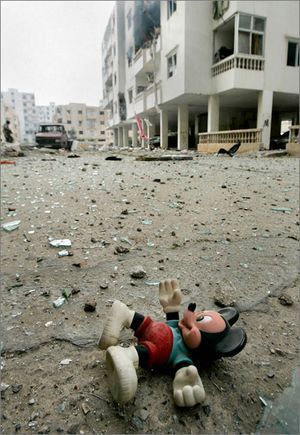Errol Morris of the NY Times Opinionator blog discusses with AP photographer Ben Curtis about toys appearing in photos from the Second Lebanon War. The interview was prompted by Slublog's 2006 post, The Passion of the Toys.
A child’s toy lies amidst broken glass from the shattered windows of an apartment block near those that were demolished by Israeli air strikes in Tyre, Southern Lebanon, Monday, August 7th, 2006.
It's worth reading because it gives a sense of the dynamic between photographers on the scene and their editors back home, what happens when a war zone is saturated with cameramen, and how photographers choose shots like this.
ERROL MORRIS: The good example, of course, is the Mickey Mouse photograph, because it is not a photograph that has been manipulated in Photoshop. And yet people find it problematic, regardless. People look at the photograph and think, “They’re trying to blame this on Israel, saying the country killed innocent children.” And then comes the follow-up thought: “How dare they! They’re anti-Semitic,” and so on and so forth. And my own two cents of opinion on posing is that often we say a picture is posed if the photograph suggests a view that we don’t like, regardless of what the intention of the photographer might have been and regardless of whether it has or has not been manipulated.
BEN CURTIS: Photoshop manipulation is one thing; caption manipulation is another thing. But there’s also a question of editing in terms of picture selection and, obviously, the pictures you select out of all the pictures you’ve shot, one can argue that that is also one area where the news is shaped. It’s what the media decides to report on. And when you’re covering a story, there’s quite often a number of different elements of that story, and you may choose certain elements to send pictures of and certain elements not to.
Curtis goes on to explain this particular Mickey Mouse photo:
When you’re covering destruction, you’re always going to focus in on details, rather than general views of destroyed buildings. You see similar pictures during a conflict like Lebanon; you see similar pictures over and over. When you come across an interesting detail in a scene . . . . But I didn’t say in my caption that children were in that apartment when it was bombed, that children were killed. I don’t know that, so I don’t say it. But if you look at my picture without the toy, you don’t know what those buildings are. It could be an office block. It could be anything. So, the inclusion of the Mickey Mouse in the picture adds an element of humanity to it. You get a feel of what was going on, what type of area it is, and that gives you a bit of a context to the fact that there have been recent air strikes in that area.


